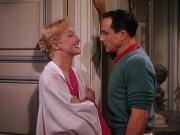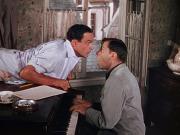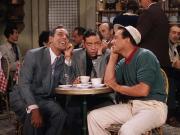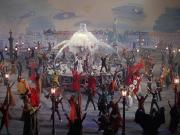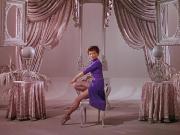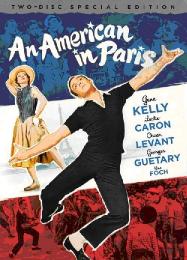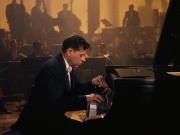Changes made to An American in Paris
Revision 5
Created on Thursday, 3rd January 2013, 13:39
Change Submitted by Alan Titherington
List of Changes:
- Title changed from 'S Wonderful! to An American in Paris
-
Change #1 -
<newline>[heading]Introduction[/heading] <newline> <newline>[i]"This is Paris..and I'm an American who lives here."[/i] <newline> <newline>The American is Jerry Mulligan, a GI who remained in Paris after the war as he wanted to follow in the footsteps of the great artists, enjoy the Bohemian life, and maybe sell a few paintings while he can. He lives in the same 'Pension' as Adam Cook, a perpetual music student and aspiring concert pianist, which, as he says himself, [i]"is a pretentious way of saying I'm unemployed at the moment".[/i] <newline> <newline>Jerry attracts a wealthy divorceé by the name of Milo ([i]"as in Venus de") [/i]who pretends to be interested in his art, and convinces him she is able to get him into the right circles so that he can become successful. She has other things in mind for him really, as she has done for several other young, aspiring artists of many types over the years. <newline> <newline>[imgmc=0000208104.jpg|0000112132] <newline>Adam is friends with a Parisian cabaret singer of a certain age named Henri Baurel. Henri is in love with a young woman called Lise who he looked after during the war. Adam listens carefully to ecstatic, but confusing descriptions as to how lovely this girl is, and treats it, as he does with most things in life, with a great deal of cynicism. <newline> <newline>Jerry and Milo decide to go to a club, where the jazz is hot and a radar is needed to navigate your way through the smoke. There, Jerry bumps into a beautiful young woman (called Lise, of course) and forces himself upon her, in the nicest possible way, so that he can dance with her. She is not to enamoured with his approach, and neither is Milo, but he manages to get her number before they leave. <newline> <newline>Appearing at Lises workplace the following day, Jerry uses all his charms to get a date with her, and Lise is considerably less defensive this time. Jerry tells Adam everything, and Adam suddenly realises there may be trouble ahead. <newline> <newline>In the local café, Jerry and Henri wax lyrical about their respective young ladies, and Adam tried his very best to change the subject ([i]Did I ever tell you about the time I gave a command performance for Hitler?[/i]), but to no avail. <newline> <newline>[imgmc=0000208108.jpg|0000112136] <newline> <newline> <newline>Towards the end, it all gets rather messy. Jerry and Lise have declared their love for each other, but then Henri is offered a singing contract in New York, and asks Lise to marry him before they leave. She accepts, and now has to tell Jerry. <newline> <newline>Everyone turns up at the 'Black & White' ball and Jerry and Lise (with Henri) come face to face, exchanging pleasantries as if they have never met. Milo recognises Lise from the club, and after a short chat with an increasingly drunk Adam, realises that there's not much more she can do. <newline> <newline>Jerry and Lise have a final heart-to-heart on the balcony and say goodbye. Henri has overheard their conversation, and realising that matters have taken a rather more serious turn the day before his supposed wedding, takes Lise home in a cab. <newline> <newline>Jerry begins to imagine what life could have been like with Lise, if things had been ever so slightly different, but it's all just a nice dream, never to be realised... <newline> <newline>[imgmc=0000208110.jpg|0000112138] <newline> <newline> or is it? <newline> <newline>[heading]Audio[/heading] <newline> <newline>Possibly the most disappointing thing about the set is that fact that film is in plain old mono. Im no expert, but some form of enhancement [i]must[/i] have been possible. As it is, things really dont improve much more than a TV broadcast on a wet Sunday afternoon. Having said that, your ears should attune themselves fairly quickly. <newline> <newline> <newline>[heading]Video[/heading] <newline> <newline>The new ultra-resolution digital transfer is actually quite impressive. There are no signs of cracks or dirt, and the colours and lighting (especially in the ballet) are quite vivid, and if the whole effect is anything like the original prints, then Alfred Gilks and John Alton gained a well-deserved Oscar. <newline> <newline>[imgmc=0000208109.jpg|0000112137] <newline> <newline> <newline>[heading]Extras[/heading] <newline> <newline>This where the set [i]really [/i]comes into its own. <newline> <newline>On Disc 1 (with the film) we have a very well put together commentary from many of those involved in the film, made up of historical interviews, and more modern recorded memories by those still alive when the special edition was being developed. Its hosted by Patricia Ward Kelly (Genes third and final wife), which is all the more remarkable, as she apparently fell out with the rest of the family many years ago. Certainly one of the most satisfying commentaries Ive come across. <newline> <newline>There is also a fascinating travelogue entitled [i]Paris on Parade [/i]which focusses on the 1937 International Exposition, which by all the evidence here, took over most of the city. Perhaps the most interesting facet of this short film is what was left out. The German pavilion (designed by Albert Speer) isnt mentioned at all, yet the Soviet offering is treated with great reverence. [i]Surely[/i] there cant have been a political point being made? <newline> <newline>A 1951 Tex Avery cartoon,[i] Symphony in Slang [/i](co-created by the brilliant Fred Quimby and Scott Bradley) revolves around a dead hipster whose language stumps even the most brilliant who are also there. Its dated, but in places very funny. Im not sure of the connection between this and the main feature, apart from the date, but its a nice addition. <newline> <newline>[imgmc=0000208105.jpg|0000112133] <newline> <newline> <newline>Disc 2 contains some hefty documentary material, the most satisfying being the [i]American Masters [/i][i]Gene Kelly Anatomy of a Dancer[/i]. Narrated by Stanley Tucci, this is a great warts-and-all story of Kellys life with filmed and audio contributions from almost everyone closely associated with his film career[b].[/b] <newline> <newline>Here, we learn that if it wasnt for Kelly losing his temper and stamping his foot so hard that it broke, that he would have starred in [i]Easter Parade[/i] and Fred Astaire may never have had a career renaissance. More fascinating (at least for me) is that Maurice Chevalier was the first choice to play Henri Baurel, but was blackballed because he had entertained the Vichy government during the war. <newline> <newline>The Making of documentary goes over some of the same material, including the story of Nina Foche (who sadly died after a fall in December 2008) catching chicken pox, giving everyone else a few days to mull over how they were actually going to get the whole ballet sequence into the end of the film. We are also inroduced to an unsung hero, Uan Rasey. You may not have heard of him (being unsung, thats not surprising), but he was the principal trumpet in the MGM orchestra, and it is him who plays that marvellous bluesy solo in the ballet sequence and is one of the most unknown but most listened-to trumpet players in film music history. <newline> <newline>In all, both documentaries stretch over two hours, and are well worth it. <newline> <newline>Interest tends to fall away after this, with some heavily scripted radio promos (most of which sound a bit odd, as all we hear are the answers, with several seconds of silence for the questions to be slipped in elsewhere) and some musical outtakes, of varying quality, both in sounds [i]and[/i] performance. <newline> <newline>[imgmc=0000208112.jpg|0000112140] <newline> <newline> <newline>[heading]Conclusion[/heading] <newline> <newline>Its actually very difficult to pass judgement about a film which is so well known (for this genre anyway), and to make any meaningful and original comments is practically impossible .but Ill give it a go. <newline> <newline>Film musicals are very strange beasts. Out of all genres, this is the one which you either love or hate, and theres very little middle ground, but there are some films which seem to break out of the mould and become something rather special. [i]Singin in the Rain [/i] and [i]The Wizard of Oz[/i] are certainly two of those, and An American in Paris [i]almost[/i] makes it. <newline> <newline>What prevents it from hitting the absolute heights is probably the story itself. Being a made up musical, its sole [i]raison-detre [/i](nice bit of French there fits the mood I think) was to show-off as much music from the George and Ira catalogue as possible, and especially to fit in the 18 or so minutes that is the orchestral work from which this film takes its name. <newline> <newline>In this respect, its a success, not least due to Alan Jay Lerners almost perfectly minimal story which could be moulded around songs that had not actually been picked when he wrote it. When songs (as in those that are sung) werent appropriate, other tunes are heard throughout, with an orchestral Embraceable You to the fore when we are introduced to Lise for the first time, and a few other nuggets played by the great Benny Carter and friends in the jazz club. <newline> <newline>Those which [i]are[/i] sung, were surprising choices in those days (apart from perhaps I got Rhythm and S Wonderful), such as Tra-la-la and Our Love is Here to Stay, but have become a staple part of the Gershwin diet since this film was made. So, another success. <newline> <newline>The final ballet sequence itself, muscially at least, isnt exactly as Gershwin wrote it, but the commentaries contain sufficient guilt expressed by the superb arrangers (notably Conrad Salinger) in that some music needed to be added so that the whole story could be told again in dance. <newline> <newline>Acting-wise, things are variable, the least satisfactory being Georges Guetary, who is so French, he becomes a stereotype, and to be honest, his singing voice, while very individual doesnt sound very pleasant. <newline> <newline>The only other real singer is Kelly himself, and even this isnt exactly his best effort (the top note in I Got Rhythm, after his aeroplane move is surprisingly off) but you can forgive him anything after that dancing. <newline> <newline>Leslie Caron turned 19 during the making of this film, and was discovered by Kelly on a trip to a ballet in Paris 4 years before. Hers is one of those rather sweet Hollywood stories, being taken under a stars wings one day and becoming a star herself the next. She does no singing herself, but dances wonderfully (apparently she suffered so badly from malnutrition during the war, that she had to take one out of two days off during filming just to recover). Her acting is also rather good, considering her English at that time was minimal, and she had little idea about cameras. <newline> <newline> <newline>[imgmc=0000208107.jpg|0000112135] <newline> <newline>Oscar Levant (Adam) is a real joy. He was, in real life, a great friend of George Gershwin, and was instrumental (pun intended) in popularising his music, especially the piano concerto. He is also one of the few people who has ever played themselves in a film ([i]Rhapsody in Blue (1945)[/i]) and his real-life cynicism and self-deprecation which prevented him from being as well-known as he deserved is brilliantly caught in the script. <newline> <newline>One of the most iconic scenes ever created in a musical is shown here, with Levant imagining himself playing the solo in his own composition (actually the Finale of the Gershwin concerto), plus all the orchestral parts, conducting, [i]and[/i] being the audience. It was apparently all Levents idea too, which shows how democratic much of the film-making process could be back then especially if those in charge were short of ideas themselves. <newline> <newline>[imgmc=0000208298.jpg|0000112382] <newline> <newline>What [i]wasnt[/i] so democratic was the choreography, and especially the its execution. Kelly was notorious for being a perfectionist (so much so that it was said you could tell the difference between someone coming out of rehearsals with Kelly, and those who has been working with Fred Astaire the Kellys were covered in bruises...purely from the strenuous rehearsal régime, I should add). <newline> <newline>But, when you see dancing with as much natural charm and energy as this, which cannot do anything [i]but [/i] bring a smile to your face, then it must have been worth it. <newline> <newline>As I have said, the whole reason for this film being made was to showcase Gershwins music, and especially to squeeze in the ballet at the end. This being the case, everything rests on whether its worth waiting for. It is of course, and if you know the music, then even the extra bits dont offend. The dancing (as it is throughout the film) is exemplary, and shows that Kelly chose well when he picked Leslie Caron as his co-star. <newline> <newline>The set design throughout the film attempts to reflect various styles of painting from luminaries such as Toulouse-Lautrec and Rousseau,and each style is caught wonderfully by the designers in the ballet itself (especially Lautrecs scene) and the direction, mostly done by Kelly himself (Minelli was going through his divorce from Judy Garland at the time), is revolutionary, cameras being placed at a very low angle and moving through the dancers rather than being static. <newline> <newline>The explosion of energy in the ballet is tangible, and its a welcome relief to get some sense of space with the ensemble working at full pelt. One of the issues faced during the filming were the relatively small sets available for the dancing, especially in Adams room for Tra-la-la and Kelly gets horribly close to booting some children in the face during I Got Rhythm so the chance to use the whole sound stage for once must have been a bit of a relief. <newline> <newline>[imgmc=0000208111.jpg|0000112139] <newline> <newline>Once the ballet is over, the film ends almost immediately. It is a musical of great moments which doesn't really hang together as a cohesive whole, but are we that worried? You learn nothing about what may happen to the main characters, apart from the fact the Henri is alone again and Jerry and Lise are together, at least for the time being. A sudden stop, yes, but the film has done its job and so theres nothing else to say. <newline> <newline>Rumour has it that a Blu-ray edition is on its way (which would [i]hopefully [/i]improve upong things sound-wise at least), and a new stage show was premiered last year, so it looks as if this particular musical isn't going to be gathering dust any time soon. <newline> <newline>Highly recommended.<newline>Review[heading]Introduction[/heading]<newline><newline>[i]"This is Paris..and I'm an American who lives here."[/i]<newline><newline>The American is Jerry Mulligan, a GI who remained in Paris after the war as he wanted to follow in the footsteps of the great artists, enjoy the Bohemian life, and maybe sell a few paintings while he can. He lives in the same 'Pension' as Adam Cook, a perpetual music student and aspiring concert pianist, which, as he says himself, [i]"is a pretentious way of saying I'm unemployed at the moment".[/i]<newline><newline>Jerry attracts a wealthy divorceé by the name of Milo ([i]"as in Venus de") [/i]who pretends to be interested in his art, and convinces him she is able to get him into the right circles so that he can become successful. She has other things in mind for him really, as she has done for several other young, aspiring artists of many types over the years.<newline><newline>[url="http://www.myreviewer.com/default.asp?a=0000112132"][imgmc=0000208104.jpg][/url]<newline>Adam is friends with a Parisian cabaret singer 'of a certain age' named Henri Baurel. Henri is in love with a young woman called Lise who he looked after during the war. Adam listens carefully to ecstatic, but confusing descriptions as to how lovely this girl is, and treats it, as he does with most things in life, with a great deal of cynicism.<newline><newline>Jerry and Milo decide to go to a club, where the jazz is hot and a radar is needed to navigate your way through the smoke. There, Jerry bumps into a beautiful young woman (called Lise, of course) and forces himself upon her, in the nicest possible way, so that he can dance with her. She is not to enamoured with his approach, and neither is Milo, but he manages to get her number before they leave.<newline><newline>Appearing at Lise's workplace the following day, Jerry uses all his charms to get a date with her, and Lise is considerably less defensive this time. Jerry tells Adam everything, and Adam suddenly realises there may be trouble ahead.<newline><newline>In the local café, Jerry and Henri wax lyrical about their 'respective' young ladies, and Adam tried his very best to change the subject ([i]"Did I ever tell you about the time I gave a command performance for Hitler?"[/i]), but to no avail.<newline><newline>[url="http://www.myreviewer.com/default.asp?a=0000112136"][imgmc=0000208108.jpg][/url]<newline><newline><newline>Towards the end, it all gets rather messy. Jerry and Lise have declared their love for each other, but then Henri is offered a singing contract in New York, and asks Lise to marry him before they leave. She accepts, and now has to tell Jerry.<newline><newline>Everyone turns up at the 'Black & White' ball and Jerry and Lise (with Henri) come face to face, exchanging pleasantries as if they have never met. Milo recognises Lise from the club, and after a short chat with an increasingly drunk Adam, realises that there's not much more she can do.<newline><newline>Jerry and Lise have a final heart-to-heart on the balcony and say goodbye. Henri has overheard their conversation, and realising that matters have taken a rather more serious turn the day before his supposed wedding, takes Lise home in a cab.<newline><newline>Jerry begins to imagine what life could have been like with Lise, if things had been ever so slightly different, but it's all just a nice dream, never to be realised...<newline><newline>[url="http://www.myreviewer.com/default.asp?a=0000112138"][imgmc=0000208110.jpg][/url]<newline><newline> or is it?<newline><newline>[heading]Audio[/heading]<newline><newline>Possibly the most disappointing thing about the set is that fact that film is in plain old mono. I'm no expert, but some form of 'enhancement' [i]must[/i] have been possible. As it is, things really don't improve much more than a TV broadcast on a wet Sunday afternoon. Having said that, your ears should attune themselves fairly quickly.<newline><newline><newline>[heading]Video[/heading]<newline><newline>The 'new ultra-resolution digital transfer' is actually quite impressive. There are no signs of cracks or dirt, and the colours and lighting (especially in the ballet) are quite vivid, and if the whole effect is anything like the original prints, then Alfred Gilks and John Alton gained a well-deserved Oscar.<newline><newline>[url="http://www.myreviewer.com/default.asp?a=0000112137"][imgmc=0000208109.jpg][/url]<newline><newline><newline>[heading]Extras[/heading]<newline><newline>This where the set [i]really [/i]comes into its own.<newline><newline>On Disc 1 (with the film) we have a very well put together commentary from many of those involved in the film, made up of historical interviews, and more modern recorded memories by those still alive when the special edition was being developed. It's hosted by Patricia Ward Kelly (Gene's third and final wife), which is all the more remarkable, as she apparently fell out with the rest of the family many years ago. Certainly one of the most satisfying commentaries I've come across.<newline><newline>There is also a fascinating 'travelogue' entitled [i]'Paris on Parade' [/i]which focusses on the 1937 International Exposition, which by all the evidence here, took over most of the city. Perhaps the most interesting facet of this short film is what was left out. The German pavilion (designed by Albert Speer) isn't mentioned at all, yet the Soviet offering is treated with great reverence. [i]Surely[/i] there can't have been a political point being made?<newline><newline>A 1951 Tex Avery cartoon,[i] 'Symphony in Slang' [/i](co-created by the brilliant Fred Quimby and Scott Bradley) revolves around a dead hipster whose language stumps even the most brilliant who are also there. It's dated, but in places very funny. I'm not sure of the connection between this and the main feature, apart from the date, but it's a nice addition.<newline><newline>[url="http://www.myreviewer.com/default.asp?a=0000112133"][imgmc=0000208105.jpg][/url]<newline><newline><newline>Disc 2 contains some hefty documentary material, the most satisfying being the [i]American Masters [/i]'[i]Gene Kelly - Anatomy of a Dancer'[/i]. Narrated by Stanley Tucci, this is a great warts-and-all story of Kelly's life with filmed and audio contributions from almost everyone closely associated with his film career[b].[/b]<newline><newline>Here, we learn that if it wasn't for Kelly losing his temper and stamping his foot so hard that it broke, that he would have starred in [i]'Easter Parade'[/i] and Fred Astaire may never have had a career renaissance. More fascinating (at least for me) is that Maurice Chevalier was the first choice to play Henri Baurel, but was blackballed because he had entertained the Vichy government during the war.<newline><newline>The 'Making of ' documentary goes over some of the same material, including the story of Nina Foche (who sadly died after a fall in December 2008) catching chicken pox, giving everyone else a few days to mull over how they were actually going to get the whole ballet sequence into the end of the film. We are also inroduced to an unsung hero, Uan Rasey. You may not have heard of him (being unsung, that's not surprising), but he was the principal trumpet in the MGM orchestra, and it is him who plays that marvellous bluesy solo in the ballet sequence and is one of the most unknown but most listened-to trumpet players in film music history.<newline><newline>In all, both documentaries stretch over two hours, and are well worth it.<newline><newline>Interest tends to fall away after this, with some heavily scripted radio promos (most of which sound a bit odd, as all we hear are the answers, with several seconds of silence for the questions to be slipped in elsewhere) and some musical outtakes, of varying quality, both in sounds [i]and[/i] performance.<newline><newline>[url="http://www.myreviewer.com/default.asp?a=0000112140"][imgmc=0000208112.jpg][/url]<newline><newline><newline>[heading]Conclusion[/heading]<newline><newline>It's actually very difficult to pass judgement about a film which is so well known (for this genre anyway), and to make any meaningful and original comments is practically impossible .but I'll give it a go.<newline><newline>Film musicals are very strange beasts. Out of all genres, this is the one which you either love or hate, and there's very little middle ground, but there are some films which seem to break out of the mould and become something rather special. [i]'Singin' in the Rain' [/i] and [i]'The Wizard of Oz'[/i] are certainly two of those, and 'An American in Paris' [i]almost[/i] makes it.<newline><newline>What prevents it from hitting the absolute heights is probably the story itself. Being a 'made up' musical, its sole [i]raison-d'etre [/i](nice bit of French there - fits the mood I think) was to show-off as much music from the George and Ira catalogue as possible, and especially to fit in the 18 or so minutes that is the orchestral work from which this film takes its name.<newline><newline>In this respect, it's a success, not least due to Alan Jay Lerner's almost perfectly 'minimal' story which could be moulded around songs that had not actually been picked when he wrote it. When songs (as in those that are sung) weren't appropriate, other tunes are heard throughout, with an orchestral 'Embraceable You' to the fore when we are introduced to Lise for the first time, and a few other nuggets played by the great Benny Carter and friends in the jazz club.<newline><newline>Those which [i]are[/i] sung, were surprising choices in those days (apart from perhaps 'I got Rhythm' and 'S Wonderful'), such as 'Tra-la-la' and 'Our Love is Here to Stay', but have become a staple part of the Gershwin diet since this film was made. So, another success.<newline><newline>The final ballet sequence itself, muscially at least, isn't exactly as Gershwin wrote it, but the commentaries contain sufficient guilt expressed by the superb arrangers (notably Conrad Salinger) in that some music needed to be added so that the whole story could be told again in dance.<newline><newline>Acting-wise, things are variable, the least satisfactory being Georges Guetary, who is so French, he becomes a stereotype, and to be honest, his singing voice, while very 'individual' doesn't sound very pleasant.<newline><newline>The only other real singer is Kelly himself, and even this isn't exactly his best effort (the top note in 'I Got Rhythm', after his aeroplane move is surprisingly off) but you can forgive him anything after that dancing.<newline><newline>Leslie Caron turned 19 during the making of this film, and was 'discovered' by Kelly on a trip to a ballet in Paris 4 years before. Her's is one of those rather sweet Hollywood stories, being taken under a star's wings one day and becoming a star herself the next. She does no singing herself, but dances wonderfully (apparently she suffered so badly from malnutrition during the war, that she had to take one out of two days off during filming just to recover). Her acting is also rather good, considering her English at that time was minimal, and she had little idea about cameras.<newline><newline><newline>[url="http://www.myreviewer.com/default.asp?a=0000112135"][imgmc=0000208107.jpg][/url]<newline><newline>Oscar Levant (Adam) is a real joy. He was, in real life, a great friend of George Gershwin, and was instrumental (pun intended) in popularising his music, especially the piano concerto. He is also one of the few people who has ever played themselves in a film ([i]Rhapsody in Blue (1945)[/i]) and his real-life cynicism and self-deprecation - which prevented him from being as well-known as he deserved - is brilliantly caught in the script.<newline><newline>One of the most iconic scenes ever created in a musical is shown here, with Levant imagining himself playing the solo in his own composition (actually the Finale of the Gershwin concerto), plus all the orchestral parts, conducting, [i]and[/i] being the audience. It was apparently all Levent's idea too, which shows how democratic much of the film-making process could be back then especially if those in charge were short of ideas themselves.<newline><newline>[url="http://www.myreviewer.com/default.asp?a=0000112382"][imgmc=0000208298.jpg][/url]<newline><newline>What [i]wasn't[/i] so democratic was the choreography, and especially the its execution. Kelly was notorious for being a perfectionist (so much so that it was said you could tell the difference between someone coming out of rehearsals with Kelly, and those who has been working with Fred Astaire - the 'Kellys' were covered in bruises...purely from the strenuous rehearsal régime, I should add).<newline><newline>But, when you see dancing with as much natural charm and energy as this, which cannot do anything [i]but [/i] bring a smile to your face, then it must have been worth it.<newline><newline>As I have said, the whole reason for this film being made was to showcase Gershwin's music, and especially to squeeze in the ballet at the end. This being the case, everything rests on whether it's worth waiting for. It is of course, and if you know the music, then even the 'extra' bits don't offend. The dancing (as it is throughout the film) is exemplary, and shows that Kelly chose well when he picked Leslie Caron as his co-star.<newline><newline>The set design throughout the film attempts to reflect various styles of painting from luminaries such as Toulouse-Lautrec and Rousseau,and each style is caught wonderfully by the designers in the ballet itself (especially 'Lautrec's' scene) and the direction, mostly done by Kelly himself (Minelli was going through his divorce from Judy Garland at the time), is revolutionary, cameras being placed at a very low angle and moving through the dancers rather than being static.<newline><newline>The explosion of energy in the ballet is tangible, and it's a welcome relief to get some sense of space with the ensemble working at full pelt. One of the issues faced during the filming were the relatively small sets available for the dancing, especially in Adam's room for 'Tra-la-la' - and Kelly gets horribly close to booting some children in the face during 'I Got Rhythm' - so the chance to use the whole sound stage for once must have been a bit of a relief.<newline><newline>[url="http://www.myreviewer.com/default.asp?a=0000112139"][imgmc=0000208111.jpg][/url]<newline><newline>Once the ballet is over, the film ends almost immediately. It is a musical of great moments which doesn't really hang together as a cohesive whole, but are we that worried? You learn nothing about what may happen to the main characters, apart from the fact the Henri is alone again and Jerry and Lise are together, at least for the time being. A sudden stop, yes, but the film has done its job and so there's nothing else to say.<newline><newline>Rumour has it that a Blu-ray edition is on its way (which would [i]hopefully [/i]improve upong things sound-wise at least), and a new stage show was premiered last year, so it looks as if this particular musical isn't going to be gathering dust any time soon.<newline><newline>Highly recommended.<newline>
Revision 4
Created on Sunday, 25th January 2009, 20:46
Change Submitted by Alan Titherington
List of Changes:
- Change #1 - ing] <newline> <newline>[i]"This is
-
Change #2 - ves here
"."[/i] <newline> <newline>The Am
Revision 3
Created on Sunday, 25th January 2009, 19:20
Change Submitted by Alan Titherington
List of Changes:
- Change #1 - mselves. <newline> <newline>[imgmc=0000208298.jpg|0000112382] <newline> <newline>What [i]wasn
- Change #2 - iately. It is a musical of great moments which doesn[apost]t really hang together as a cohesive whole, but are we that worried? You lear
Revision 2
Created on Sunday, 25th January 2009, 19:13
Change Submitted by Alan Titherington
List of Changes:
-
Change #1 - 945)[/i]
-
Change #2 - pefully
Revision 1
Created on Sunday, 25th January 2009, 13:48
Change Submitted by Alan Titherington
List of Changes:
- Change #1 - to say. <newline> <newline>Rumour has it that a Blu-ray edition is on its way (which would [i]hopefully [/i]improve upong things sound-wise at least), and a new stage show was premiered last year, so it looks as if this particular musical isn[apost]t going to be gathering dust any time soon. <newline> <newline>Highly recommended.
Initial Version
Created on Sunday, 25th January 2009, 13:40
First Submitted by Alan Titherington
